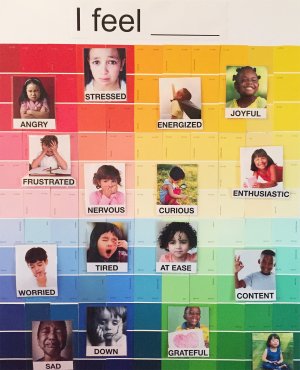Supporting Young Students’ Emotional Well-Being
Teachers in the early grades can guide young students to better understand, express, and handle their emotions.
Your content has been saved!
Go to My Saved Content.Social and emotional learning is often spoken of as the “missing piece” in education, but integrating SEL into academics is essential to a healthy, harmonious classroom. Checking in emotionally with students is a simple, effective way for teachers to connect with students and begin to equip them with lifelong tools to communicate their feelings and needs. As students are grappling with the major changes and potential traumatic experiences caused by the pandemic, this practice is more important than ever.
While teaching at an urban Title 1 elementary school in Central Los Angeles, I witnessed firsthand the power of SEL and how crucial emotional skills development and practicing emotional check-ins were to my students’ success. At the beginning of the 2019–20 school year, getting through a lesson while putting out fires was a constant challenge. My first-grade students had big emotions but lacked the words to communicate their feelings and needs. Their frustration caused multiple meltdowns, and academic collaboration usually ended up in arguments or even physical fights.
Age-Appropriate SEL
According to the Los Angeles Unified School District, many of the students in the district¬Ýwere at risk for traumatic stress before the pandemic, so I knew I had to provide a safe, trauma-informed classroom space. I also knew I had to integrate foundational SEL skills in ways that were appropriate for my students‚Äô age.
The Collaborative for Academic, Social, and Emotional Learning (CASEL), a leader in advancing evidence-based social and emotional learning,¬Ý¬Ýof core SEL competencies that correspond to students‚Äô age and stage of development. For our youngest students, there are related to self-management and self-awareness, including the ability to handle emotions in productive ways.
Simply put, being able to first identify and then express how they feel sets children up to successfully manage and cope with emotions. These skills are the foundation of emotional literacy, and we need them at any age.¬Ý
Understanding Moods and Feelings
To lay this groundwork, I began inviting students to share how they felt and why, if they were comfortable, during our daily morning circle. To teach my students the vocabulary to identify and express their feelings, I designed a Feelings Chart labeled with a vocabulary of emotions and accompanying photos of children’s facial expressions.

I adapted the visual concept of the , a tool for identifying and sorting emotions for people of all ages. The Mood Meter sorts emotions on a gradient scale ranging from high to low energy, pleasant to unpleasant, and gives equal representation for positive and negative emotions.¬Ý
While looking for ready-made flash cards or photos of children’s emotional expressions for my chart to help my emerging readers, I was disappointed to find resources that depicted nearly all white children. I gathered an assortment of public domain photos to reflect the racial demographics of our Los Angeles population. Our Feelings Chart is sorted into four zones: high-energy pleasant yellow zone (energized, joyful, curious, enthusiastic); high-energy unpleasant red zone (angry, stressed, frustrated, nervous); low-energy pleasant green zone (at ease, content, grateful, serene); and low-energy unpleasant blue zone (tired, worried, down, sad). To create the color background, I cut out and pasted paint swatches together on poster board.
Increasing the Vocabulary of Emotions
After only two days, the majority of my students went from saying they felt “good” or “tired” to saying they felt “energized,” “down,” “serene,” or “joyful.” We talked about what the words meant, and my students worked together in groups to sort photos of children’s facial expressions into the color zones. Once my students understood how to identify emotions, we talked about what strategies to use to positively shift how they feel in various situations: asking for help from an adult, taking a break in a dedicated calm classroom space, using words during a conflict, etc.
Gradually, I noticed this vocabulary showing up in students’ conversations and collaboration. Arguments didn’t solely end in students just walking away; with some support, they could talk it out and keep working together in class. After three months, we moved on to reflective listening. During circle time, students paired up with an elbow partner, and, using a visual anchor chart I created, they took turns expressing how they felt, mirroring their partner’s language and recalling a time when they felt similarly, if possible.
Over the course of the year, I noticed the atmosphere of my classroom slowly transform. Our academic time became richer and significantly more cohesive. Some students stepped into the role of peer supporter using the work I had modeled for them, asking each other how they felt and offering helpful suggestions when they looked upset.
SEL and Classroom Management
There are huge implications in this related to class management. Devoting time to social and emotional subjects seemed to send the message to students that their emotions are valid and welcome in the classroom and that their emotional well-being is important. As we engaged in discourse, we created a language of understanding influenced by each community member.
During the first wave of the pandemic, when our school campus transitioned to online learning, my students continued using the vocabulary naturally from our Feelings Chart even without the visual aid. Students expressed that they felt disappointed because they couldn’t see their friends or felt sad because they were lonely. We continued our practice of brainstorming strategies to feel better, and other students seamlessly stepped in to share ideas. This practice had become part of our classroom culture.
In-person classes are back in session for most schools, and who knows what students have encountered in the last year. According to the American Academy of Pediatrics, more than 140,000 children in the United States , and countless others have lost vital supports while combating the ongoing stress, fear, grief, and uncertainty created by the pandemic.
Emotionally checking in daily with students allows educators to respond to students’ trauma and get them the at-school support and counseling they need, work that I continue daily. I saw my students lean on these strategies we explored as a class while living through uncertainty and change, which speaks to the power of these practices—not only for young students but for students of all ages.
